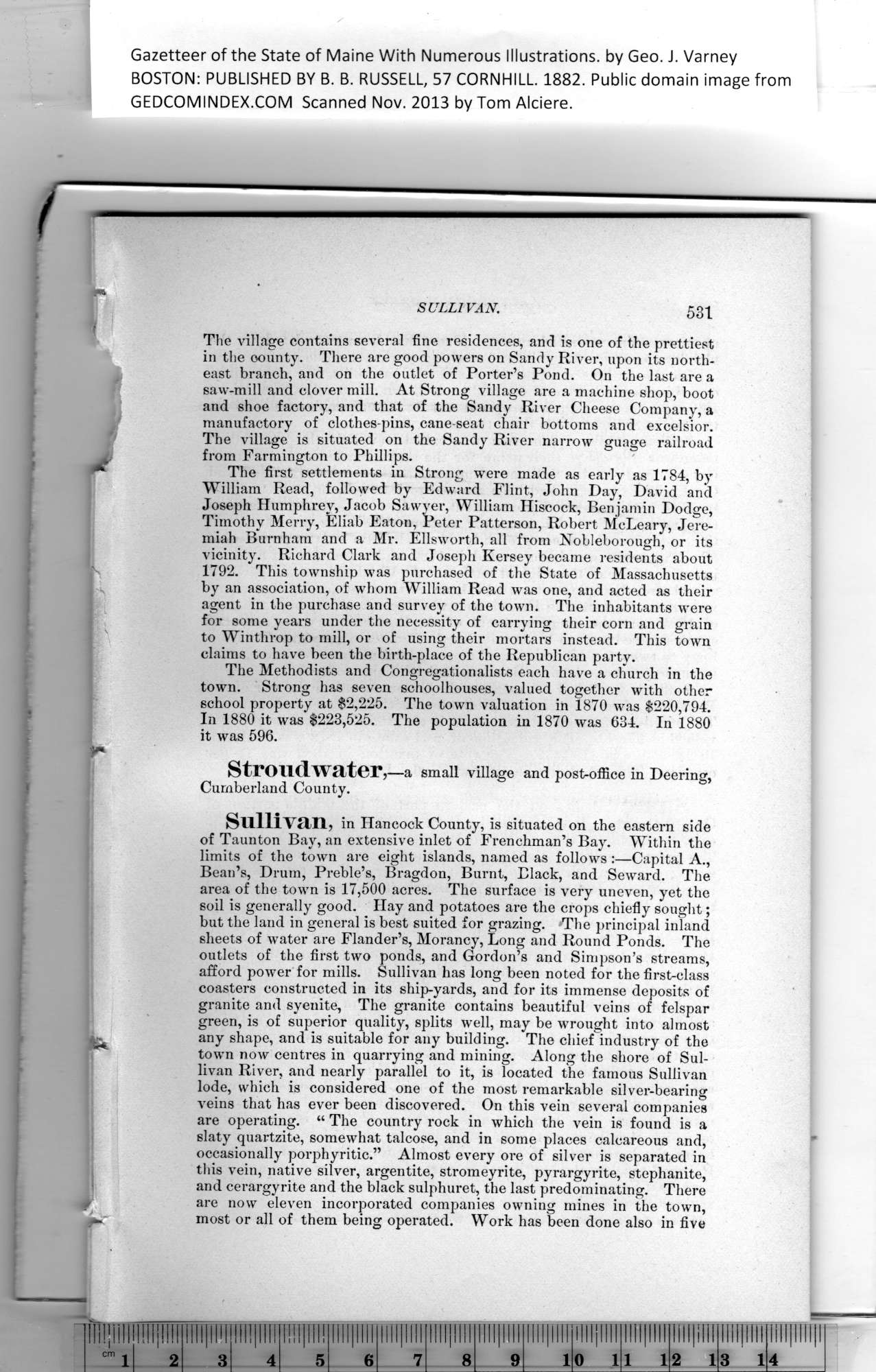|
Gazetteer of the State of Maine With Numerous Illustrations, by Geo. J. Varney
BOSTON: PUBLISHED BY B. B. RUSSELL, 57 CORNHILL. 1882. Public domain image from
SULLIVAN. 53P
The village contains several fine residences, and is one of the prettiest
in the oounty. There are good powers on Sandy River, upon its north-
east branch, and on the outlet of Porter’s Pond. On the last are a
saw-mill and clover mill. At Strong village are a machine shop, boot
and shoe factory, and that of the Sandy River Cheese Company, a
manufactory of clothes-pins, cane-seat chair bottoms and excelsior.
The village is situated on the Sandy River narrow guage railroad
m from Farmington to Phillips.
^ The first settlements in Strong wrere made as early as 1784, by
William Read, followed by Edward Flint, John Day, David and
Joseph Humphrey, Jacob Sawyer, William Hiscock, Benjamin Dodge,
Timothy Merry, Eliab Eaton, Peter Patterson, Robert McLeary, Jere-
miah Burnham and a Mr. Ellsworth, all from Nobleborough, or its
vicinity. Richard Clark and Joseph Kersey became residents about
1792. This township was purchased of the State of Massachusetts
by an association, of whom William Read was one, and acted as their
agent in the purchase and survey of the town. The inhabitants were
for some years under the necessity of carrying their corn and grain
to Winthrop to mill, or of using their mortars instead. This town
claims to have been the birth-place of the Republican party.
The Methodists and Congregationalists each have a church in the
town. Strong has seven schoolhouses, valued together with other
school property at $2,225. The town valuation in 1870 was $220,794.
In 1880 it was $223,525. The population in 1870 was 634. In 1880
it was 596.
y*
Stroudwater,—a small village and post-office in Deering,
Cumberland County.
Sullivan, in Hancock County, is situated on the eastern side
of Taunton Bay, an extensive inlet of Frenchman’s Bay. Within tbe
limits of the town are eight islands, named as follows :—Capital A.,
Bean’s, Drum, Preble’s, Bragdon, Burnt, Black, and Seward. The
area of the town is 17,500 acres. The surface is very uneven, yet the
soil is generally good. Hay and potatoes are the crops chiefly sought;
but tbe land in general is best suited for grazing. The principal inland
sheets of water are Flander’s, Morancy, Long and Round Ponds. The
outlets of the first two ponds, and Gordon’s and Simpson’s streams,
afford power for mills. Sullivan has long been noted for the first-class
coasters constructed in its ship-yards, and for its immense deposits of
granite and syenite, The granite contains beautiful veins of felspar
green, is of superior quality, splits well, may be wrought into almost
any shape, and is suitable for any building. The chief industry of the
town now centres in quarrying and mining. Along the shore of Sul-
livan River, and nearly parallel to it, is located the famous Sullivan
lode, which is considered one of the most remarkable silver-bearing
veins that has ever been discovered. On this vein several companies
are operating. “ The country rock in which the vein is found is a
slaty quartzite, somewhat talcose, and in some places calcareous and,
occasionally porphyritic.” Almost every ore of silver is separated in
this vein, native silver, argentite, stromeyrite, pyrargyrite, stephanite,
1 and cerargyrite and the black sulphuret, the last predominating. There
f' are now eleven incorporated companies owning mines in the town,
jpc most or all of them being operated. Work has been done also in five
PREVIOUS PAGE ... NEXT PAGE
This page was written in HTML using a program written in Python 3.2
|
